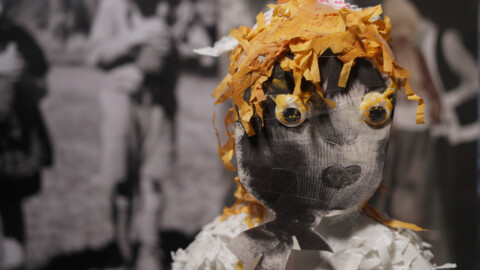Children’s films are generally made by adults. As such, they reflect certain ideas concerning what children enjoy or what is important to them. They are not only entertaining, but usually aim to educate children by teaching them social values and behaviour. Often they relate stories of wondrous experiences featuring cute or strange creatures that may be fascinating and unsettling at the same time.
Annika Eriksson is interested in these multi-layered aspects of children’s culture. Her spatial installation of the same name includes two video works: on the one hand, she shows cut-out figures that she has assembled into groups, and on the other, she has invited children from Leipzig to create their own environment without the guidance of adults.
Kinderkultur was realised as part of the exhibition series Trampolin-TV, which draws attention to a special chapter in the history of children’s television. It deals with the period between 1965 and 1985, when television became more and more widespread as a mass medium. Many iconic children’s films and series were produced at this time, including Sesame Street (USA), Unser Sandmännchen (Our Little Sandman, GDR), The Mole (Czechoslovakia) or Professor Balthazar (Yugoslavia). Last but not least, children’s culture at the time was shaped by the political ideologies that divided the world into “east” and “west.” This tension, as well as the conflict between liberal and authoritarian education, between aesthetic education and commercial entertainment, made public television a platform for important social debates.
At the centre of Annika Eriksson’s artistic practice is an interest in social interaction: how do we live together, what kind of societies do we create, and what happens on the margins or at the point of transition between one social order and the next? Her project is also concerned with the relationship between humans and animals, with our interdependency, differences and connections, but also with violations and the animal as a specific projection surface for humans. Her work has been exhibited in various institutions such as the Bonner Kunstverein, Künstlerhaus Stuttgart, Hamburger Bahnhof, Berlin, Tate Liverpool and at biennales in Venice, Sao Paulo, Istanbul and Vienna.
Annika Eriksson would like to thank Ben Brix (camera), Sarah Davachi (sound), Fuchs Borst (graphic design), Lena Seik (gfzk for you) and the children who participated in the project.
Kinderkultur is part of the exhibition series Trampolin-TV: Vom Kinderfernsehen zur zeitgenössischen Kunst und Literatur, curated by Maria Lind and Andjeas Ejiksson and created in collaboration with Fabrika Moscow, Kalmar Art Museum, Bildmuseet Umeå.
With the kind support of IASPIS and the Swedish Embassy Berlin.
